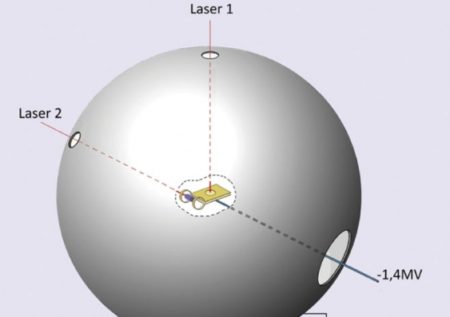Dec
19
Path to Hydrogen Boron Fusion Now Viable
December 19, 2017 | 3 Comments
University of New South Wales scientists now argue that the path to hydrogen-boron fusion is now viable. Hydrogen-boron fusion (HBF) may be closer to realization than other approaches, such as the deuterium-tritium fusion approach currently being pursued such as the International Thermonuclear Experimental Reactor (ITER) effort.
Closer or not, HBF will much more easily enter the public relation arena with way less radioactive baggage than the hugely problematic tokamak devices. The researchers say a laser-driven technique for creating fusion that dispenses with the need for radioactive fuel elements and leaves no toxic radioactive waste is now within reach.

Schematic of a Hydrogen Boron Fusion Reactor. Image Credit: University of New South Wales. Click image for the largest view.
Dramatic advances in powerful, high-intensity lasers are making it viable for scientists to pursue what was once thought impossible: creating fusion energy based on hydrogen-boron reactions. And an Australian physicist is in the lead, armed with a patented design and working with international collaborators on the remaining scientific challenges.
In a paper in the scientific journal Laser and Particle Beams, lead author Heinrich Hora from the University of New South Wales in Sydney and international colleagues argue that the path to hydrogen-boron fusion is now viable, and may be closer to realization than other approaches, such as the deuterium-tritium fusion approach being pursued by U.S. National Ignition Facility (NIF) and the ITER under construction in France.
Hora, who predicted in the 1970s that fusing hydrogen and boron might be possible without the need for thermal equilibrium said, “I think this puts our approach ahead of all other fusion energy technologies.” Rather than heat fuel to the temperature of the Sun using massive, high-strength magnets to control superhot plasmas inside a doughnut-shaped toroidal chamber (as in NIF and ITER), hydrogen-boron fusion is achieved using two powerful lasers in rapid bursts, which apply precise non-linear forces to compress the nuclei together.
Hydrogen-boron fusion produces no neutrons and, therefore, no radioactivity in its primary reaction. And unlike most other sources of power production – like coal, gas and nuclear, which rely on heating liquids like water to drive turbines – the energy generated by hydrogen-boron fusion converts directly into electricity. But the downside has always been that HBF needs much higher temperatures and densities – almost 3 billion degrees Celsius, or 200 times hotter than the core of the Sun.
However, dramatic advances in laser technology are close to making the two-laser approach feasible, and a spate of recent experiments around the world indicate that an ‘avalanche’ fusion reaction could be triggered in the trillionth-of-a-second blast from a petawatt-scale laser pulse, whose fleeting bursts pack a quadrillion watts of power. If scientists could exploit this avalanche, Hora said, a breakthrough in proton-boron fusion was imminent.
Hora, an emeritus professor of theoretical physics at the University of New South Wales said, “It is a most exciting thing to see these reactions confirmed in recent experiments and simulations. Not just because it proves some of my earlier theoretical work, but they have also measured the laser-initiated chain reaction to create one billion-fold higher energy output than predicted under thermal equilibrium conditions.”
Together with 10 colleagues in six nations – including from Israel’s Soreq Nuclear Research Center and the University of California, Berkeley – Hora describes a roadmap for the development of hydrogen-boron fusion based on his design, bringing together recent breakthroughs and detailing what further research is needed to make the reactor a reality.
An Australian spin-off company, HB11 Energy, holds the patents for Hora’s process. “If the next few years of research don’t uncover any major engineering hurdles, we could have prototype reactor within a decade,” said Warren McKenzie, managing director of HB11. “From an engineering perspective, our approach will be a much simpler project because the fuels and waste are safe, the reactor won’t need a heat exchanger and steam turbine generator, and the lasers we need can be bought off the shelf.”
This is very welcome news, indeed. We just need to keep in mind that this press release isn’t misleading rather its optimally optimistic. There is quite a way yet to go, but the road isn’t looking so dim or fogged over. The other questions are: which process will be the first to get net output? Which can get competitively commercial first? It looks like we’re going to find out.
Comments
3 Comments so far


This is very welcome news, indeed. We just need to keep in mind that this press release isn’t misleading rather its optimally optimistic.
From an engineering perspective, our approach will be a much simpler project because the fuels and waste are safe, the reactor won’t need a heat exchanger and steam turbine generator, and the lasers we need can be bought off the shelf.
This is an exciting prospect for fusion development however there does seem to be a significant amount of materials engineering work ahead regarding the electron capture system. Also, from a review of the reactions for aneutronic fusion it seems that significant thermal energy, via other radiation pathways, is still created so a heat exchanger may still be in the cards. That isn’t a bad thing, if you can capture this lower grade energy too. I look forward to seeing it work!